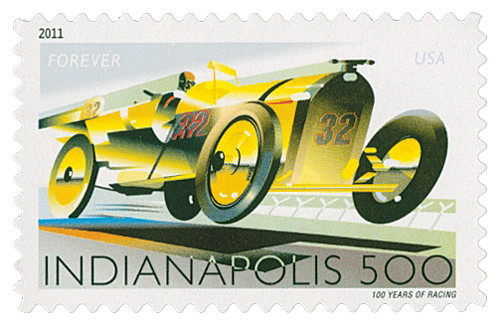
# 4530 - 2011 First-Class Forever Stamp - Indianapolis 500
Issue Date: May 20, 2011
City: Indianapolis, Indiana
Quantity: 50,000,000
Printed By: Banknote Corporation of America, Sennett Security Products
Indianapolis 500
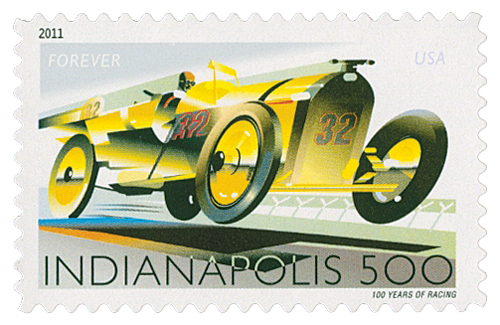
On May 30, 1911, the Indianapolis Motor Speedway held its first 200-lap, 500-mile race, dubbed the Indianapolis (or Indy) 500.
One of Indiana’s biggest attractions is the Indianapolis Motor Speedway, initially built for automotive research and to test new car models. After breaking ground in March 1909, it was completed in August of the same year. The first weekend of racing took place that same month, but immediately encountered tragedy – several crashes resulted in five deaths. To fix the problem, the entire track was resurfaced with 3.2 million bricks, with the last one made of gold. This earned the racetrack the nickname the “Brickyard.”
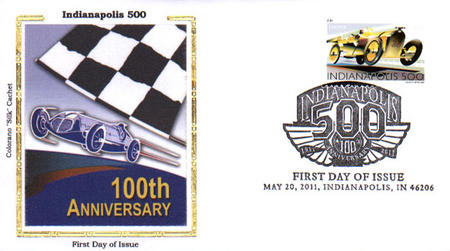
Over the next year, thousands of people came out to the speedway to watch a variety of races. The largest was the Decoration Day (today’s Memorial Day) weekend race in 1910. After that, attendance dropped and the speedway’s owners decided to focus on a single race. They first considered a 24-hour race or perhaps a 1,000-mile race, but ultimately selected 500 miles as the race could be completed before dark. For the first race, they offered a $25,000 prize.
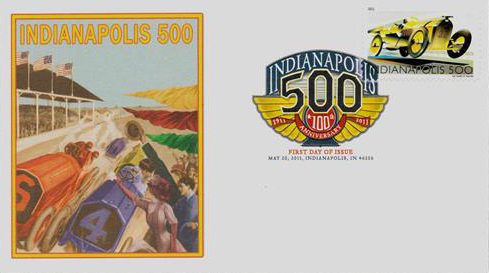
The inaugural race came on May 30, 1911. A total of 40 drivers entered the race, including Ray Harroun, a retired racecar driver and engineer for the Marmon Motor Car Company. He came out of retirement for the race with his Wasp, a unique vehicle that had its motor up front under the hood (most motors were hung on the rear axle) and used a double-frame suspension system.
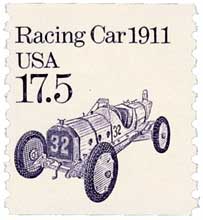
Harroun drove his Wasp around the track at an average speed of just over 74 miles per hour. Several people accused him of recklessness, as he was the only driver in the race without a spotter riding alongside to alert him to oncoming traffic, and his Wasp featured a new-fangled contraption known as a “rear-view mirror.” Harroun went on to become the first winner of the Indy 500 with a time of 6 hours, 42 minutes.
The Indy 500 has been held almost every year since except during the World Wars. Over the years, the bricks slowly disappeared as parts of the track were paved with asphalt. In 1961, all but a three-foot-wide section of brick at the start/finish line was paved. The three-foot strip is a tribute to the “yard of brick,” or “Brickyard.”
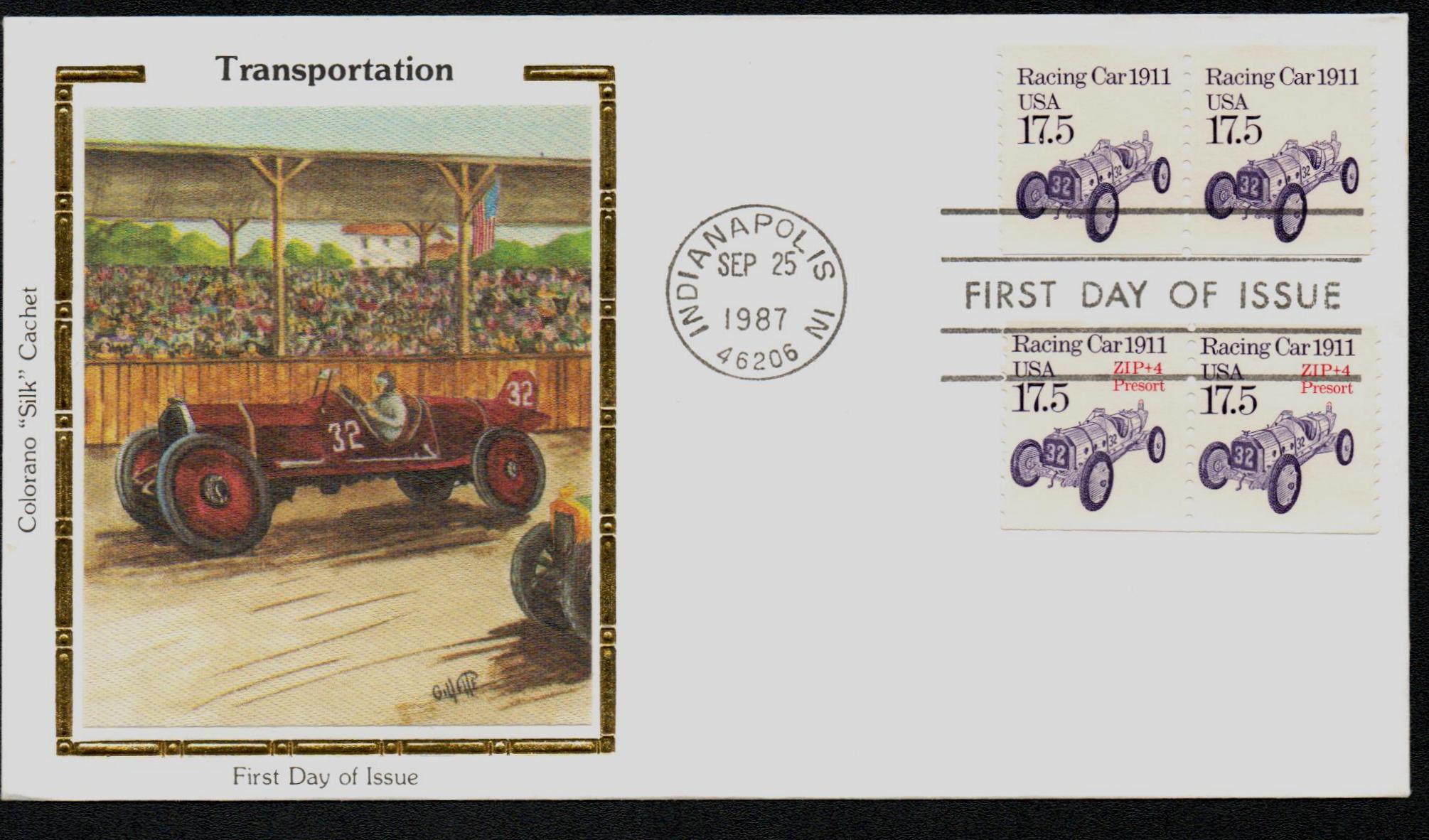
The Indy 500 is now limited to vehicles featuring open wheels known as “Indy Cars.” Foreign drivers gradually made the Indianapolis Speedway their primary base and the race gained international fame. Advances in technology added excitement, with speeds now exceeding 225 miles per hour.

Many Indy 500 traditions have developed over the years, including patriotic songs, pork tenderloin sandwiches, and a superstition against eating peanuts. Perhaps the most famous is the Indy’s call to action – “Gentlemen, start your engines!”
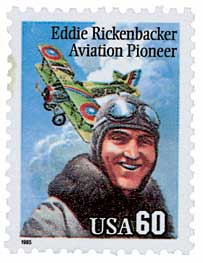
For over 100 years, fans have thronged to Indianapolis for the thrill of watching “The Greatest Spectacle in Racing.” The annual Memorial Day event attracts some of the biggest names in auto racing along with about 400,000 enthusiasts from around the world. Today, the speedway is the world’s largest sports facility.
Click here for lots more car stamps.
Issue Date: May 20, 2011
City: Indianapolis, Indiana
Quantity: 50,000,000
Printed By: Banknote Corporation of America, Sennett Security Products
Indianapolis 500

On May 30, 1911, the Indianapolis Motor Speedway held its first 200-lap, 500-mile race, dubbed the Indianapolis (or Indy) 500.
One of Indiana’s biggest attractions is the Indianapolis Motor Speedway, initially built for automotive research and to test new car models. After breaking ground in March 1909, it was completed in August of the same year. The first weekend of racing took place that same month, but immediately encountered tragedy – several crashes resulted in five deaths. To fix the problem, the entire track was resurfaced with 3.2 million bricks, with the last one made of gold. This earned the racetrack the nickname the “Brickyard.”

Over the next year, thousands of people came out to the speedway to watch a variety of races. The largest was the Decoration Day (today’s Memorial Day) weekend race in 1910. After that, attendance dropped and the speedway’s owners decided to focus on a single race. They first considered a 24-hour race or perhaps a 1,000-mile race, but ultimately selected 500 miles as the race could be completed before dark. For the first race, they offered a $25,000 prize.

The inaugural race came on May 30, 1911. A total of 40 drivers entered the race, including Ray Harroun, a retired racecar driver and engineer for the Marmon Motor Car Company. He came out of retirement for the race with his Wasp, a unique vehicle that had its motor up front under the hood (most motors were hung on the rear axle) and used a double-frame suspension system.

Harroun drove his Wasp around the track at an average speed of just over 74 miles per hour. Several people accused him of recklessness, as he was the only driver in the race without a spotter riding alongside to alert him to oncoming traffic, and his Wasp featured a new-fangled contraption known as a “rear-view mirror.” Harroun went on to become the first winner of the Indy 500 with a time of 6 hours, 42 minutes.
The Indy 500 has been held almost every year since except during the World Wars. Over the years, the bricks slowly disappeared as parts of the track were paved with asphalt. In 1961, all but a three-foot-wide section of brick at the start/finish line was paved. The three-foot strip is a tribute to the “yard of brick,” or “Brickyard.”

The Indy 500 is now limited to vehicles featuring open wheels known as “Indy Cars.” Foreign drivers gradually made the Indianapolis Speedway their primary base and the race gained international fame. Advances in technology added excitement, with speeds now exceeding 225 miles per hour.

Many Indy 500 traditions have developed over the years, including patriotic songs, pork tenderloin sandwiches, and a superstition against eating peanuts. Perhaps the most famous is the Indy’s call to action – “Gentlemen, start your engines!”

For over 100 years, fans have thronged to Indianapolis for the thrill of watching “The Greatest Spectacle in Racing.” The annual Memorial Day event attracts some of the biggest names in auto racing along with about 400,000 enthusiasts from around the world. Today, the speedway is the world’s largest sports facility.
Click here for lots more car stamps.

